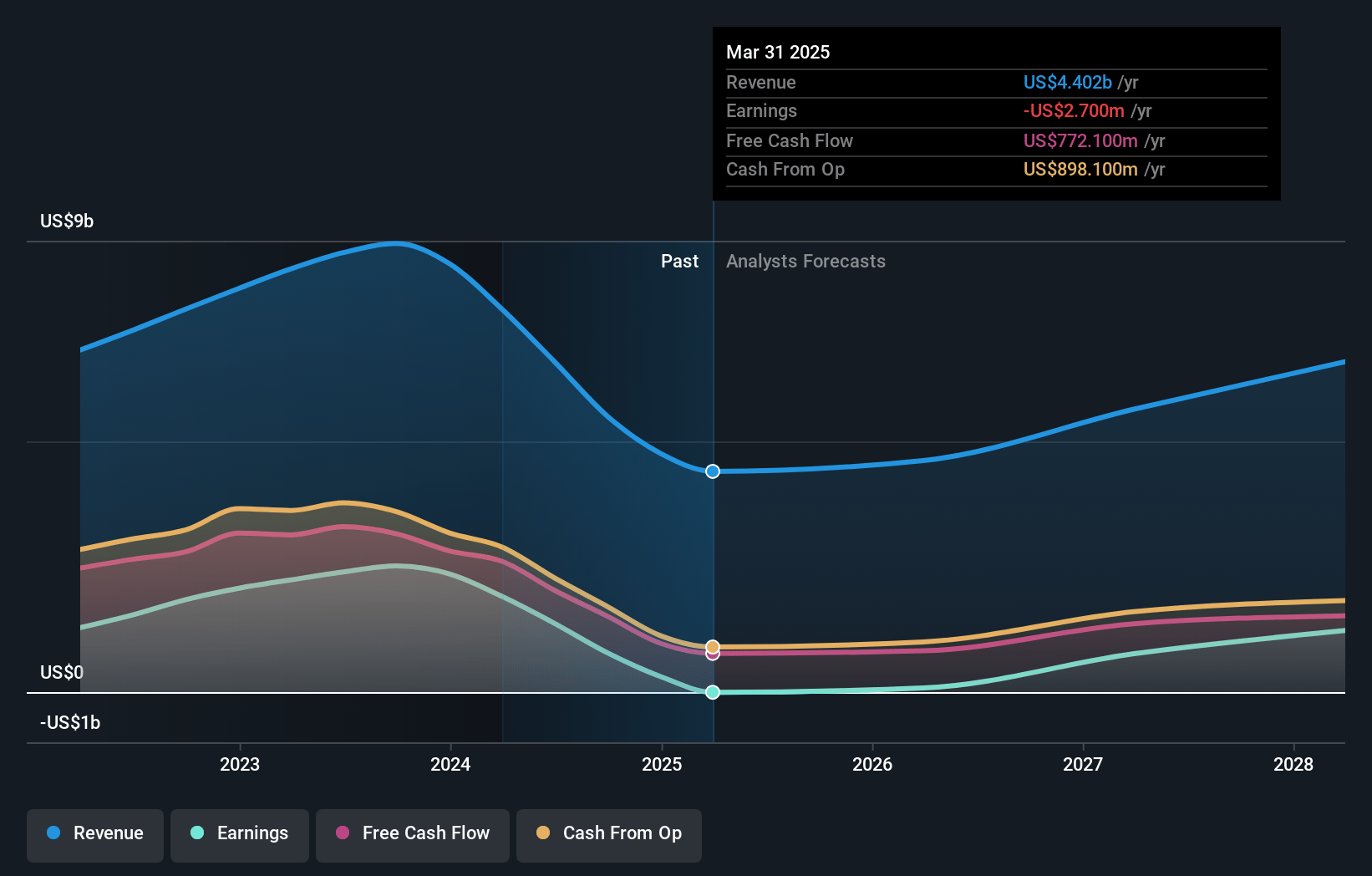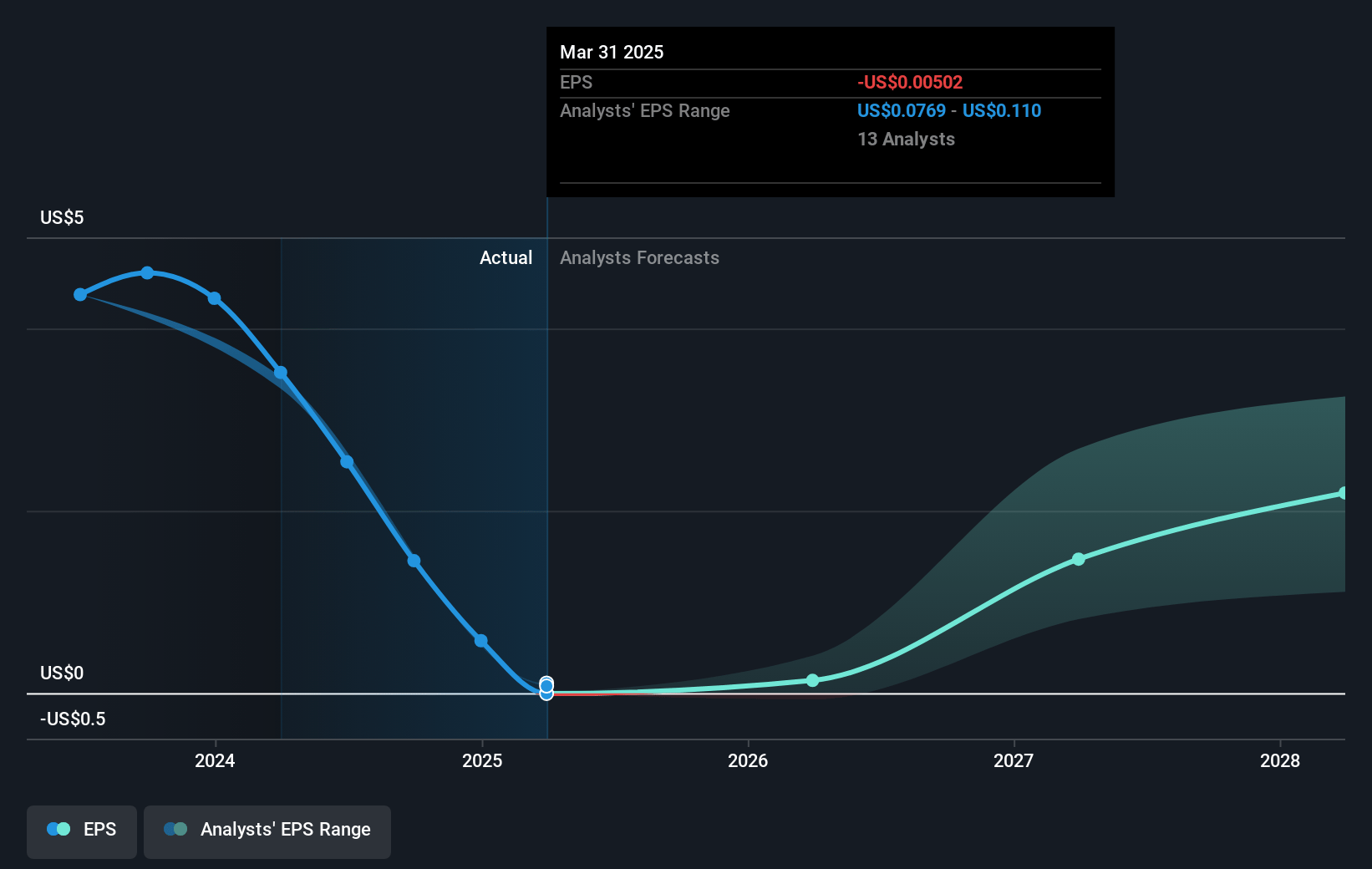Key Takeaways
- Restructuring efforts and cost-cutting measures aim to improve net margins and operational efficiency through capacity optimization and reduced operating expenses.
- Strategic changes focus on inventory reduction, enhancing distributor incentives, and strengthening customer relationships to drive cash flow and revenue growth.
- Operational efficiency risks, broad market weakness, rising expenses, execution risks, and financial pressures could impact Microchip's revenue, earnings, and financial stability.
Catalysts
About Microchip Technology- Engages in the development, manufacture, and sale of smart, connected, and secure embedded control solutions in the Americas, Europe, and Asia.
- The decision to close the Tempe Fab and resize manufacturing capacity is a significant operational change aimed at cost efficiency. This could positively impact net margins by reducing fixed costs and improving capacity utilization in existing facilities.
- The aggressive plan to reduce inventory days from 266 to a target of 130-150 days is set to free up approximately $250 million in cash, which would enhance their cash flow and potentially improve earnings as inventory carrying costs decrease.
- Microchip’s restructuring of its business units for increased efficiency and synergy is expected to lower operating expenses in the long run, which could boost net margins as operational costs are streamlined.
- Changes in Microchip’s channel strategy that incentivize new product promotion by distributors are expected to drive future revenue growth by pushing new products into the market more rapidly.
- The focus on strengthening customer relationships, particularly the top 1,000 customers, suggests a strategic push to drive sales growth and expand market share, which could result in higher future revenues.
Microchip Technology Future Earnings and Revenue Growth
Assumptions
How have these above catalysts been quantified?- This narrative explores a more pessimistic perspective on Microchip Technology compared to the consensus, based on a Fair Value that aligns with the bearish cohort of analysts.
- The bearish analysts are assuming Microchip Technology's revenue will grow by 12.6% annually over the next 3 years.
- The bearish analysts assume that profit margins will increase from 6.5% today to 23.1% in 3 years time.
- The bearish analysts expect earnings to reach $1.6 billion (and earnings per share of $2.9) by about April 2028, up from $308.8 million today. The analysts are largely in agreement about this estimate.
- In order for the above numbers to justify the price target of the more bearish analyst cohort, the company would need to trade at a PE ratio of 25.5x on those 2028 earnings, down from 67.4x today. This future PE is greater than the current PE for the US Semiconductor industry at 23.0x.
- Analysts expect the number of shares outstanding to grow by 0.17% per year for the next 3 years.
- To value all of this in today's terms, we will use a discount rate of 10.03%, as per the Simply Wall St company report.
Microchip Technology Future Earnings Per Share Growth
Risks
What could happen that would invalidate this narrative?- The closure of Microchip's Fab 2 and the presence of excess inventory, which needs substantial reduction, pose risks to operational efficiency and could affect their future revenue and net margins.
- The sequential decline of key revenue streams across all major geographies and product lines indicates broad market weakness that could affect their earnings growth potential.
- Rising operating expenses, partly due to the end of previous pay cuts, might pressure net margins and profitability in the short term.
- The dependence on the successful execution of the 9-point plan, including channel strategy updates and business unit reorganization, introduces execution risks that could impact both revenue and earnings if not effectively managed.
- The elevated net debt-to-EBITDA ratio and the challenges in maintaining a consistent free cash flow to cover dividends point to financial risks that could pressure their financial stability and liquidity.
Valuation
How have all the factors above been brought together to estimate a fair value?- The assumed bearish price target for Microchip Technology is $55.37, which represents one standard deviation below the consensus price target of $64.52. This valuation is based on what can be assumed as the expectations of Microchip Technology's future earnings growth, profit margins and other risk factors from analysts on the more bearish end of the spectrum.
- However, there is a degree of disagreement amongst analysts, with the most bullish reporting a price target of $80.0, and the most bearish reporting a price target of just $35.0.
- In order for you to agree with the bearish analysts, you'd need to believe that by 2028, revenues will be $6.8 billion, earnings will come to $1.6 billion, and it would be trading on a PE ratio of 25.5x, assuming you use a discount rate of 10.0%.
- Given the current share price of $38.71, the bearish analyst price target of $55.37 is 30.1% higher.
- We always encourage you to reach your own conclusions though. So sense check these analyst numbers against your own assumptions and expectations based on your understanding of the business and what you believe is probable.
How well do narratives help inform your perspective?
Disclaimer
AnalystLowTarget is an employee of Simply Wall St, but has written this narrative in their capacity as an individual investor. AnalystLowTarget holds no position in NasdaqGS:MCHP. Simply Wall St has no position in the company(s) mentioned. Simply Wall St may provide the securities issuer or related entities with website advertising services for a fee, on an arm's length basis. These relationships have no impact on the way we conduct our business, the content we host, or how our content is served to users. This narrative is general in nature and explores scenarios and estimates created by the author. The narrative does not reflect the opinions of Simply Wall St, and the views expressed are the opinion of the author alone, acting on their own behalf. These scenarios are not indicative of the company's future performance and are exploratory in the ideas they cover. The fair value estimate's are estimations only, and does not constitute a recommendation to buy or sell any stock, and they do not take account of your objectives, or your financial situation. Note that the author's analysis may not factor in the latest price-sensitive company announcements or qualitative material.
Read more narratives







